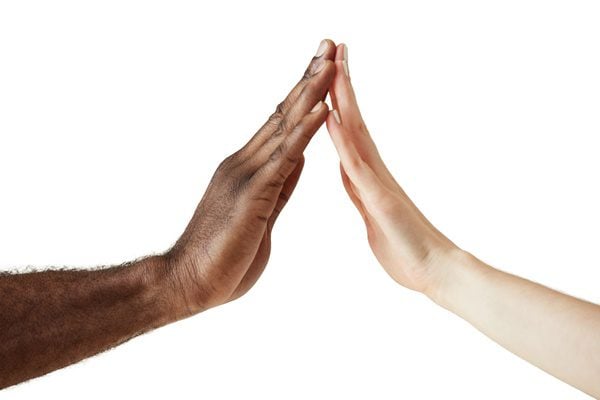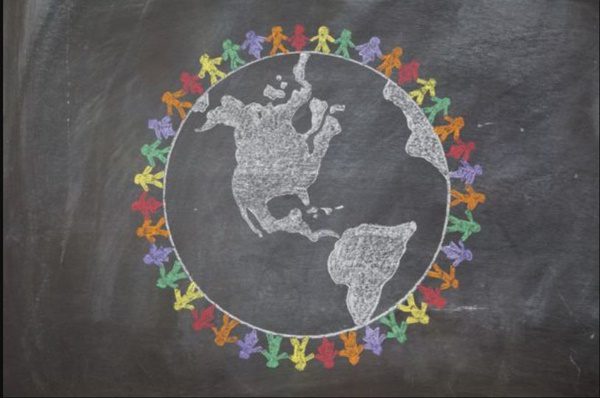A Failure To Apply Mimetic Theory To Racism
To be white and actively anti-racist in the United States is to be in a continual state of repentance.
That does not mean a constant state of guilt. But it does mean that those of us who inevitably experience racial privilege at the expense of others need to make a greater effort to turn and see what is already clear to our neighbors of color: that we live on a fractured foundation of injustice.
A few months ago, I wrote about applying mimetic theory to our understanding of racism. Used carefully, mimetic theory can help us understand racism as an integral component of the myth – that is, the deceptive lie of structural violence – that precariously upholds our culture. Mimetic theory, which illuminates our interconnected human nature and our profound influence on one another, can be a crucial tool for dismantling racism. But misapplied, mimetic theory might hinder efforts at racial reconciliation and even feed the beast of racism. I wrote about two misapplications of mimetic theory that concerned me: (1) fearing reverse racism through vengeance and (2) putting the onus on people of color to eradicate racism through forgiveness. Now, I am seeing another failure to apply mimetic theory positively to the transformation of racism to universal human rights: conflating bigotry with racism, and conflating white responsibility with white guilt.
Mimetic theory can help clarify the differences between bigotry and racism as well as guilt and responsibility. When bigotry is confused with racism, the less overt but more deeply-structured injustices remain hidden and unhealed within our culture. And when responsibility is confused with guilt, progress is stymied and resentment builds.
The Invention of the White Race
We must move away from a personal definition of racism (which is more accurately defined as bigotry) to a systemic definition. This process begins when we recognize that race is not a biological feature but a social construct, and, as Theodore Allen explains in The Invention of the White Race, a tool of social and economic control.
While there have been tribal divisions and conflicts throughout history, the thorough dehumanization and domination of other human beings based on skin color was a new phenomenon in the American colonies enhanced by pseudoscience and a gross distortion of Christianity. If race is a social construct, then it was socially constructed by those with power – wealthy landowners of European descent– in order to safeguard that power against potential threats. In fact, an understanding of mimetic theory helps illuminate the invention of the white race itself as one method of scapegoating in order to stave off another.
Indentured servitude, for people of African and European descent, preceded slavery. The wealthy elite were from England, but the vast majority of colonists from England (and all from Ireland) were poor and bound to service for a number of years. Discrimination according to color grew and slavery for those of African descent crept in before it was formally institutionalized, but conditions were horrific for all bonded servants. Poor and indentured people of all shades found common cause to unite against wealthy rulers, most famously in Bacon’s Rebellion. After that uprising, the ruling class sought to protect its rule by broadening the divide between blacks and poor or indentured whites. This was when the term “white” itself began to appear, and the divide between “white” and black was deliberately enhanced by granting nominal rights to the former and removing any rights or gains from the latter. The ruling class used divisions of race to break bonds of class.
With a system of racial division, the ruling elites were able not only to exploit and dehumanize African slaves, but also placate poor white people by giving them status over people of color. Losing solidarity with black people also meant losing real economic opportunity for advancement, but that loss was masked by a few small economic privileges and an outlet for indulging in the human desire to affirm identity over and against others as poor white people took comfort in the lies told about black people. Lies used to justify slavery demonized black people and made cruelty righteous. After abolition, lies persisted and became the backbone of segregation, discrimination, and lynching.
This systematic oppression was also a systematic brainwashing. It didn’t affect all white people equally, as some people were abolitionists and some people were less rabidly anti-black than others. But it did so thoroughly permeate and poison the common understanding of race that even abolitionists (and later, allies) absorbed common misperceptions.
The Necessity of Understanding Racism as A System, Not an Attitude
Furthermore, and perhaps more importantly, the oppression of racism granted advantage to white people regardless of personal attitude. However a white person may have felt about a black person, being born white meant being born with freedom while being born black overwhelmingly meant being born a slave (unless one’s parents had run away to freedom or been set free). And after abolition, employment and housing were systematically denied to African Americans. Benefits were granted explicitly and exclusively to whites. Personal attitude didn’t matter; it was the American system that was thoroughly racist.
Today it is impossible to find an area of United States culture untouched by racism. It is not simply that attitudes cultivated over centuries take more than a couple of generations to undo. It is also a wealth gap cultivated over generations of unpaid and underpaid labor and denial of access to benefits, a de-facto segregation that comes both from redlining policies of the past and continued loan discrimination, employment discrimination, unequal access to educational resources, school-to-prison pipelines, disproportionate targeting of African Americans by law enforcement, and so much more. All of this comes by way of very deliberate design woven into the fabric of American social life since before the United States even became a nation.
The white race was invented specifically to subjugate black people, and other people of color were deemed lesser as well according to the system that created white identity. Racism in the United States was created as a one-way street. This is why we must not conflate racism with bigotry. Hatred according to color or nationality can go in any direction, but racism was specifically designed to elevate “white” above people of color.
Ways Mimetic Theory Can Illuminate and Help Dismantle Racism
Mimetic theory can be a valuable tool for understanding racism. It can help us understand the scapegoating mechanism used to forge white identity over and against black people by helping us understand the human propensity to define ourselves by what we are against rather than who we are. This helps make sense of the formation of white identity, since there was no “white” before wealthy landowners found a reason to create whiteness so that they themselves would not be targeted based on what others had in common against them; i.e., poverty vs. wealth.
Mimetic theory can also help us understand how racism spread so easily and became such an insidious and pernicious system even though race is not a biological feature. Humans are creatures designed to learn from each other and formulate our desires through the desires of others. In other words, we are relational beings whose sense of self is built through our relationships with others. So when a system was designed to subjugate and then separate black people from white people through slavery and segregation, that system kept white and black people from being in relationship with one another for generations. The lies and propaganda also poisoned white minds against African Americans, and our human propensity to learn not just facts but passions and desires and attitudes from each other facilitated the spread of anti-black propaganda like a contagion, permeating science and religion as well as conventional wisdom and taking deep root in the white collective psyche.
Furthermore, mimetic theory can help us understand why “colorblindness” cannot be a solution to racism. Mimetic theory helps us understand how we blind ourselves to our own violence by masking it in a sense of righteousness. Racism is a powerful example of people believing so thoroughly in their own goodness over and against the wickedness of others that they cannot recognize their violence even when it is so blatant and cruel. When we create a narrative so thoroughly blind to our own faults even as we demonize others, this is what mimetic theory calls myth. Conquering civilizations create myths to define themselves over and against those they conquer. Nations create myths against enemy nations. Racism is a particularly vicious myth created to demonize people of color and thus justify every act of exploitation and expulsion.
“Colorblindness” sees the harm in discriminating on the basis of color, but it does not uproot the myth of racism because it does not face the depths of the violence. White people who claim to be “colorblind” are blind not to color but to the ways systemic racism so thoroughly permeates every aspect of the lives of people of color. They often define racism only by attitude instead of recognizing its systemic nature (or, if they do recognize it, they are still unwilling or unable to grasp the extent of it). This means they do not define racism according to those who, because they live under its oppression, are thus able to see more clearly than even the most educated white ally its multifaceted manifestations.
Colorblindness hinders progress in transforming racism into equality by wrongfully defining racism and thus mis-prescribing the cure. For example, someone claiming colorblindness may suggest getting rid of Affirmative Action for college admissions, wrongfully claiming that such a program discriminates against white people, but missing the ways discrimination in housing and education make getting into college more difficult for African Americans. Affirmative Action is a partial correction to those injustices. Mimetic Theory, on the other hand, teaches us to look for and uproot myths – systems of human violence hidden under layers of justification – by encouraging us to see through what James Alison calls the “intelligence of the victim,” but in this case what I prefer to call the intelligence of the survivor. In other words, mimetic theory teaches us that the world is most clearly seen and understood by those on the receiving end of injustice. Mimetic theory encourages us to seek the ugly truth under the glossy veneer of myth in order to transform it. In the case of racism, this means that white people need to listen to people of color in order to understand the violence of racism in its inescapable ubiquity. And mimetic theory also helps us find hope, because just as lies can be spread through negative mimesis, through positive mimesis, the healing balm of truth can spread as well.
White Responsibility: It’s Not About Guilt
With all I have said about the invention of the white race and need to see racism in its pervasive, violent ugliness, I now must say something about white guilt. It is not easy, as someone who identifies as white, to read that the white race was invented to subjugate people of color. When the realization of the depths of racism by deliberate design begins to sink in, it can be a terribly sobering feeling.
Defining racism primarily by attitude has allowed white people to believe that anyone can be racist, and anyone can choose not to be racist. To learn that racism is a system of advantage based on race, and that it is a thoroughly one-way street, does not come easily. To learn that whatever disadvantages white people may otherwise face, we hold the racial advantage, and when we do not actively work against it, we inevitably participate in systemic racism, can feel overwhelming. We all want to see the best within ourselves and are reluctant to look at our faults, and to let the truth about racism sink in is a very difficult thing for white people who had thought ourselves to be “good guys” or even “allies” to do.
Many people will object to this understanding of racism with sentiment akin to, “I didn’t choose to be white. I won’t feel guilty about it. And I have nothing to do with racism.” The first of these statements is undeniably true and the second can be healthy, but these three sentences put together are deadly.
No, we did not choose to be white, and no, we did not set up the system of racism. We were born into it, however, and although we are not responsible for the sin and ignorance of those who came before us, we are responsible for seeing how racism still permeates our society. And we are responsible for the role we must play in dismantling and transforming it.
Because a system was created to deny rights to all people of color, white people hold a racial advantage, whether or not we asked for it. Our individuality does not exempt us from white privilege precisely because the individuality of people of color was denied by generations of legal and de facto segregation and the wealth gaps and stereotypes that come with them. A system of racial oppression has undermined the individuality of both white people and people of color. This does not mean that we suffer the effects of racism equally, but it does mean that we are not truly free until our neighbors of color are free. The more we understand our history, and the more we listen to people of color, the more we can turn our racist culture around.
Knowing that I was born into a society built on racism, and knowing that I am the product of my relationships in a still largely-segregated society, I find it helpful to recognize that I am part of a racist system, and that I have to actively strive against it. I find it helpful to recognize how racism resides in me as a manifestation of original sin (the inescapable reality of being born into a world of sin). When the myopia of my limited perspective hurts someone, I am troubled, I feel sorry, and I strive to do better. A sense of guilt for the ways I hurt people is appropriate, as long as I use it as encouragement to make amends and be better, and discard it when it has served that purpose. But I do not feel an overriding guilt for what I cannot change, that is, for being white. That kind of guilt is paralyzing and regressive. It causes resentment which perpetuates racism. No one is asking white people to feel perpetually guilty. Rather, we must recognize the necessity of seeing the truth about racism in order to transform a deadly system and thus set all of us free.
Understanding the truth about racism is not about guilt. It’s about throwing off the blinders of myth, seeing racism for what it is, and recognizing our responsibility to dismantle it. It’s about recognizing that beyond the imposed system of racial division, we are truly one human race, and we can only live into the best of who we are meant to be when we acknowledge what we can do to change the worst within ourselves and our society.
Image: “Black and White Hands” by Mirko Vitali via 123rf.com.
Stay in the loop! Like Teaching Nonviolent Atonement on Facebook!












